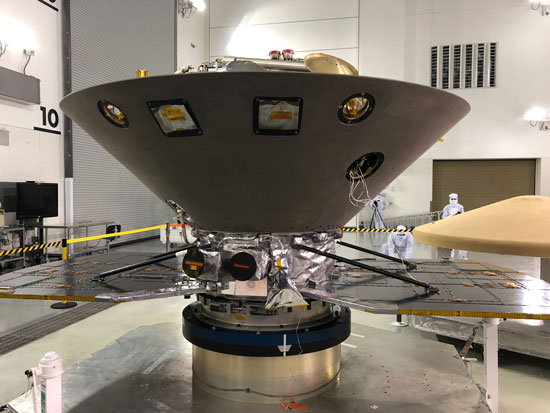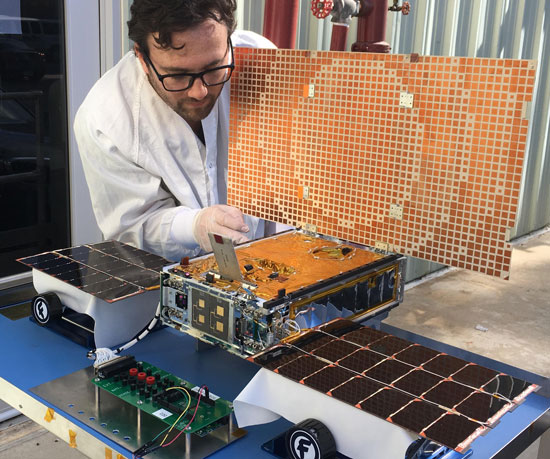
The next mission to put a lander on Mars launched on Saturday at 7:05 a.m. Eastern Daylight Time. Called Interior Exploration using Seismic Investigations, Geodesy and Heat Transport, or InSight, this NASA mission aims to improve understanding about the formation and evolution of Mars and other small, rocky planets by looking beneath Mars’s surface.
 The InSight lander in a holding facility at Vandenberg Air Force Base undergoing prelaunch preparations. Credit: NASA/JPL-Caltech
The InSight lander in a holding facility at Vandenberg Air Force Base undergoing prelaunch preparations. Credit: NASA/JPL-Caltech
The mission will probe the interior of a terrestrial planet other than Earth for the first time, explained NASA chief scientist Jim Green at a prelaunch press briefing on 3 May. InSight will give scientists an idea of the sizes of Mars’s core, mantle, and crust, which they can then compare with interior structures of Earth. Such knowledge “is of fundamental importance for us to understand the origin of our solar system and how it became the way it is today,” Green said.
InSight hosts three primary instruments: a seismometer, a heat probe, and a radio science system. With data from those instruments, the InSight team hopes to learn more about Mars’s interior structure and composition, its rate of heat loss, its current tectonic activity level, and the frequency of meteorite impacts on the planet. These data will also help researchers learn more about precession of the planet’s rotational axis.
Knowing more about Mars’s history and evolution will lead to better understanding of Earth’s, explained InSight principal investigator Bruce Banerdt. “When we start to look back into the Earth’s history,” he said, “we run into a brick wall because the Earth is so active that the evidence of [early geological] processes has gotten erased.” Mars is a good substitute, said Banerdt, because it has “a lot of geologic activity on the surface, but all of the fingerprints of those early processes are still retained in the deep interior.” Banerdt is a research scientist at NASA’s Jet Propulsion Laboratory (JPL) in Pasadena, Calif.
Although InSight also hosts two cameras, their purpose is to gauge the scientific potential and hazard level at possible landing sites in Elysium Planitia. They will not provide detailed images of the Martian surface. After landing, placing surface instruments, and deploying its subsurface heat probe, the entire lander must remain as steady as possible to obtain ultraprecise measurements of seismic activity and surface impacts. Wary of vibrations that might affect those measurements, the mission plans no movements of its cameras postlanding.
Launch Included First Interplanetary CubeSats JPL engineer Joel Steinkraus tests solar panels on one of the MarCO CubeSats. Credit: NASA/JPL-Caltech
JPL engineer Joel Steinkraus tests solar panels on one of the MarCO CubeSats. Credit: NASA/JPL-Caltech
To send data back to Earth, InSight will team up with NASA’s Mars Cube One (MarCO) mission, which launched aboard the same rocket on Saturday but will independently travel to Mars. MarCO comprises a pair of CubeSats, the first two to visit another planet. If they arrive intact, MarCO will act as part of a communications relay for InSight data.
The CubeSat mission will be the first “field” test of miniaturized deep-space communications equipment and will assess the viability of using CubeSats beyond Earth. Should MarCO fail, InSight will still be able to transmit its data back to Earth with its own equipment and through other Mars orbiters.
InSight and MarCO launched aboard a United Launch Alliance Atlas V-401 rocket from Vandenberg Air Force Base Space Launch Complex 3 in California, the first interplanetary launch from the U.S. West Coast. InSight is scheduled to land on Mars and begin its 708-sol (roughly 2-Earth-year) mission on 26 November.
—Kimberly M. S. Cartier (@AstroKimCartier), Staff Writer
The post New Lander en Route to Probe the Red Planet’s Interior appeared first on Eos.
from Eos https://eos.org/articles/new-lander-en-route-to-probe-the-red-planets-interior?utm_source=rss&utm_medium=rss&utm_content=new-lander-en-route-to-probe-the-red-planets-interior
via IFTTT

